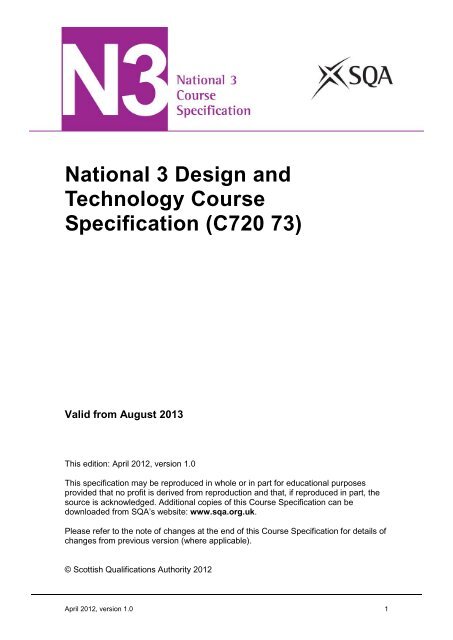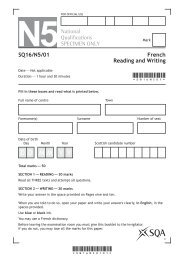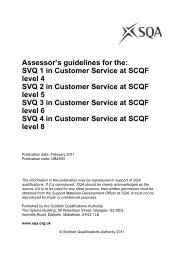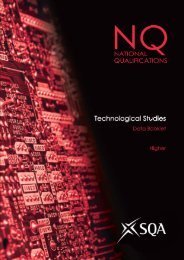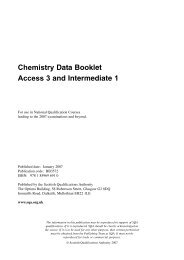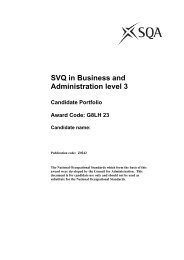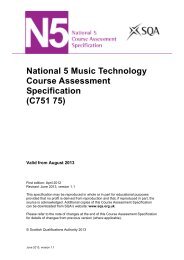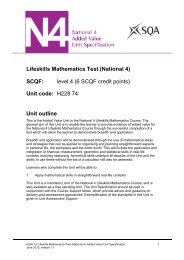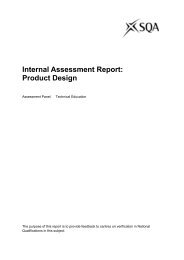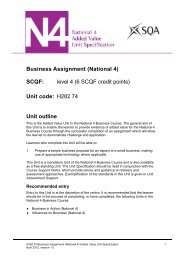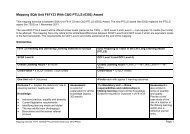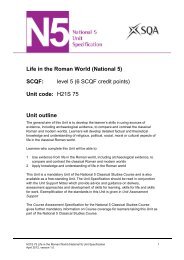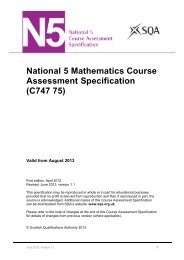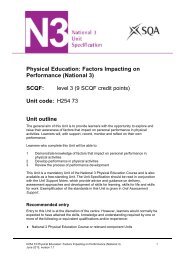CfE_CourseSpec_N3_Technologies_DesignandTechnology - SQA
CfE_CourseSpec_N3_Technologies_DesignandTechnology - SQA
CfE_CourseSpec_N3_Technologies_DesignandTechnology - SQA
Create successful ePaper yourself
Turn your PDF publications into a flip-book with our unique Google optimized e-Paper software.
National 3 Design and<br />
Technology Course<br />
Specification (C720 73)<br />
Valid from August 2013<br />
This edition: April 2012, version 1.0<br />
This specification may be reproduced in whole or in part for educational purposes<br />
provided that no profit is derived from reproduction and that, if reproduced in part, the<br />
source is acknowledged. Additional copies of this Course Specification can be<br />
downloaded from <strong>SQA</strong>’s website: www.sqa.org.uk.<br />
Please refer to the note of changes at the end of this Course Specification for details of<br />
changes from previous version (where applicable).<br />
© Scottish Qualifications Authority 2012<br />
April 2012, version 1.0 1
Course outline<br />
Course title:<br />
SCQF:<br />
National 3 Design and Technology<br />
level 3 (18 SCQF credit points)<br />
Course code: C720 73<br />
Mandatory Units<br />
H22X 73 Graphics for Design (National 3) 6 SCQF credit points<br />
H22Y 73 Designing and Modelling (National 3) 6 SCQF credit points<br />
H230 73 Constructing and Testing (National 3) 6 SCQF credit points<br />
Recommended entry<br />
Entry to this Unit is at the discretion of the centre. However, relevant experiences and<br />
outcomes may provide an appropriate basis for doing this Course.<br />
Progression<br />
This Course or its Units may provide progression to:<br />
♦ National 4 Graphic Communication<br />
♦ National 4 Engineering Science<br />
♦ National 4 Design and Manufacture<br />
♦ other qualifications in the technologies curriculum area<br />
♦ further study, employment and/or training<br />
Further details are provided in the Rationale section.<br />
Equality and inclusion<br />
This Course Specification has been designed to ensure that there are no unnecessary<br />
barriers to learning or assessment. The individual needs of learners should be taken<br />
into account when planning learning experiences, selecting assessment methods or<br />
considering alternative evidence. For further information, please refer to the Course<br />
Support Notes.<br />
April 2012, version 1.0 1
Rationale<br />
All new and revised National Courses reflect Curriculum for Excellence values,<br />
purposes and principles. They offer flexibility, provide more time for learning, more<br />
focus on skills and applying learning, and scope for personalisation and choice.<br />
In this Course, and its component Units, there will be an emphasis on skills<br />
development and the application of those skills. Assessment approaches will be<br />
proportionate, fit for purpose and will promote best practice, enabling learners to<br />
achieve the highest standards they can.<br />
This Course provides learners with opportunities to continue to acquire and develop the<br />
attributes and capabilities of the four capacities as well as skills for learning, skills for<br />
life and skills for work.<br />
All Courses provide opportunities for learners to develop breadth, challenge and<br />
application, but the focus and balance of the assessment will be appropriate for the<br />
subject area.<br />
Relationship between the Course and Curriculum for<br />
Excellence values, purposes and principles<br />
This Course provides an engaging introduction to the design process in a technological<br />
context, in a way that allows for personalisation and choice.<br />
The Course provides opportunities for learners to work effectively alongside others in a<br />
shared workshop or similar environment. The skills that learners acquire by<br />
successfully completing this Course will be valuable for learning, for life and for the<br />
world of work.<br />
The Course encourages learners to become successful, responsible and creative in<br />
their use of technologies. It allows them to continue to acquire and develop the<br />
attributes and capabilities of the four capacities, including: creativity, flexibility and<br />
adaptability; enthusiasm and a willingness to learn; perseverance, independence and<br />
resilience; responsibility and reliability; and confidence and enterprise.<br />
The Course provides progression mainly from the craft, design, engineering and<br />
graphics experiences and outcomes.<br />
April 2012, version 1.0 2
Purpose and aims of the Course<br />
The Course provides a broad practical introduction to design and to technology. It<br />
provides opportunities for learners to gain basic skills in both designing and in<br />
communicating design ideas. It allows learners to explore and amend design ideas<br />
through model making and testing, in both product design and engineering contexts.<br />
The Course provides opportunities to develop and enhance practical creativity,<br />
practical problem solving skills, and an appreciation of safe working practices in a<br />
workshop or similar environment.<br />
The aims of the Course are to enable learners to:<br />
♦ develop skills in producing and interpreting sketches, drawings and diagrams<br />
♦ develop skills in practical model making and construction<br />
♦ develop skills in testing and simple evaluation of models<br />
♦ apply safe working practices in a workshop or similar environment<br />
♦ develop knowledge of basic engineering ideas<br />
The Course introduces learners to ideas and skills which they may then choose to take<br />
forward through further study in the technologies curriculum area.<br />
Information about typical learners who might do the Course<br />
This Course is a broad-based qualification for learners with an interest in design and in<br />
practical technology. It provides sufficient breadth, flexibility and choice to meet the<br />
needs of all learners.<br />
The Course is also suitable for any learner who wants to progress to higher levels of<br />
study in graphic communication, practical crafts, design and manufacture, or<br />
engineering science.<br />
Course activities also provide opportunities to build self-confidence, generic and<br />
transferable skills in numeracy, employability skills, thinking skills, and skills in planning<br />
and organising of work tasks, working independently and in collaboration with others,<br />
as well as skills in communication and self- and peer-evaluation, in a technological<br />
design context.<br />
April 2012, version 1.0 3
Course structure and conditions of award<br />
Course structure<br />
The Course is practical, exploratory and experiential in nature. Throughout the Course,<br />
learners will develop basic design skills, use graphic communication within the design<br />
process, and develop practical skills in making, constructing and testing models.<br />
Learners will also gain some knowledge of basic engineering ideas and the ability to<br />
apply their knowledge and skills to solve simple problems.<br />
Units may be taught sequentially or in parallel. Learning and teaching approaches<br />
should provide opportunities to integrate skills where possible.<br />
Units are statements of standards for assessment and not programmes of learning and<br />
teaching. They can be delivered in a number of ways.<br />
The Course comprises three mandatory Units.<br />
Graphics for Design (National 3)<br />
In this Unit, learners will develop skills in producing drawings, sketches and diagrams<br />
to support the design process. Learners will use computer-aided and/or manual graphic<br />
communication tools and techniques.<br />
Designing and Modelling (National 3)<br />
In this Unit, learners will follow, with guidance, a simple design process. They will make<br />
a simple physical model from design drawings, and refine the design based on simple<br />
evaluation of the model. Through these activities, learners will develop awareness of<br />
sustainability and recycling.<br />
Constructing and Testing (National 3)<br />
In this Unit, learners will develop an understanding of structures and mechanisms by<br />
solving simple engineering problems. They will construct (or simulate) and test simple<br />
models to demonstrate one or more of strengthening, energy transfer or movement.<br />
Learners will draw conclusions based on the test results.<br />
In each of the three Units above, learners will develop and apply safe working practices<br />
in a workshop or similar environment.<br />
Conditions of award<br />
To achieve the National 3 Design and Technology Course, learners must pass all of<br />
the required Units. The required Units are shown in the Course outline section.<br />
National 3 Courses are not graded.<br />
April 2012, version 1.0 4
Skills, knowledge and understanding<br />
Full skills, knowledge and understanding for the Course are given in the Course<br />
Support Notes. A broad overview of the subject skills, knowledge and understanding<br />
that will be covered in the Course is given in this section.<br />
These include:<br />
♦ skills in producing, with guidance, sketches, drawings and diagrams<br />
♦ skills in interpreting simple sketches, drawings and diagrams<br />
♦ applying, with guidance, a simple design process<br />
♦ following, with guidance, a simple problem solving process<br />
♦ basic skills in constructing (or simulating) and testing simple models<br />
♦ safe use of a range of tools and equipment in a workshop or similar environment<br />
♦ basic knowledge of simple engineering ideas<br />
♦ an appreciation of sustainability issues<br />
Skills, knowledge and understanding to be included in the Course will be appropriate to<br />
the SCQF level of the Course. The SCQF level descriptors give further information on<br />
characteristics and expected performance at each SCQF level (www.sqa.org.uk/scqf).<br />
April 2012, version 1.0 5
Assessment<br />
Further information about assessment for the Course is included in the Course Support<br />
Notes.<br />
Unit assessment<br />
All Units are internally assessed against the requirements shown in the Unit<br />
Specification.<br />
They can be assessed on an individual Unit basis or by using other approaches which<br />
combine the assessment for more than one Unit.<br />
They will be assessed on a pass/fail basis within centres. <strong>SQA</strong> will provide rigorous<br />
external quality assurance, including external verification, to ensure assessment<br />
judgments are consistent and meet national standards.<br />
The assessment of the Units in this Course will be as follows.<br />
Graphics for Design (National 3)<br />
For this Unit, learners will be required to provide evidence of skills in producing<br />
sketches, drawings and diagrams, and designing and producing a promotional display.<br />
Designing and Modelling (National 3)<br />
For this Unit, learners will be required to provide evidence of basic design skills, skills<br />
in making physical models, and awareness of sustainability issues.<br />
Constructing and Testing (National 3)<br />
For this Unit, learners will be required to provide evidence of skills in constructing (or<br />
simulating) and testing simple engineering solutions.<br />
April 2012, version 1.0 6
Development of skills for learning, skills for life<br />
and skills for work<br />
It is expected that learners will develop broad, generic skills through this Course. The<br />
skills that learners will be expected to improve on and develop through the Course are<br />
based on <strong>SQA</strong>’s Skills Framework: Skills for Learning, Skills for Life and Skills for Work<br />
and drawn from the main skills areas listed below. These must be built into the Course<br />
where there are appropriate opportunities.<br />
2 Numeracy<br />
2.2 Money, time and measurement<br />
4 Employability, enterprise and citizenship<br />
4.2 Information and communication technology (ICT)<br />
5 Thinking skills<br />
5.2 Understanding<br />
5.3 Applying<br />
Amplification of these skills is given in <strong>SQA</strong>’s Skills Framework: Skills for Learning,<br />
Skills for Life and Skills for Work. The level of these skills will be appropriate to the<br />
level of the Course. Further information on building in skills for learning, skills for life<br />
and skills for work for the Course is given in the Course Support Notes.<br />
April 2012, version 1.0 7
Administrative information<br />
Published: April 2012 (version 1.0)<br />
History of changes to National Course Specification<br />
Course<br />
details<br />
Version Description of change Authorised<br />
by<br />
Date<br />
This specification may be reproduced in whole or in part for educational purposes<br />
provided that no profit is derived from reproduction and that, if reproduced in part, the<br />
source is acknowledged. Additional copies of this specification can be downloaded<br />
from <strong>SQA</strong>’s website at www.sqa.org.uk.<br />
Note: You are advised to check <strong>SQA</strong>’s website (www.sqa.org.uk) to ensure you are<br />
using the most up-to-date version of the Course Specification.<br />
© Scottish Qualifications Authority 2012<br />
April 2012, version 1.0 8


